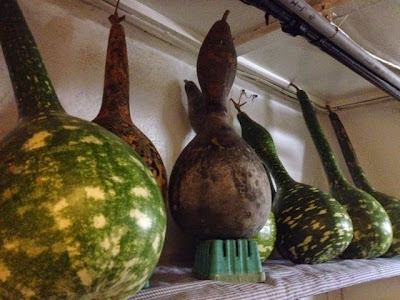As winter draws close, the first section on my homestead to-do list looks a bit like this
1) Add bedding to chicken coop
2) Finish building up terraced paths to chicken coop with cardboard and wood chips
3) Make some sort of outdoor covered space in the chicken run area
I am sensing a theme here....bawk!
So, how do chickens do in the winter? Quite well, really! Our chicken coop itself is meant to ventilate, not insulate. The structure will not "hold heat"....it's really only a hardware cloth wrapped frame with a tarp tied (fairly tidily) around it. The hens stay warm by huddling on the roosts at night and the tarp keeps the howling wind off them. Folks have different theories with how warm the birds need to be, but my theory on getting chickens through winter (borrowed from lots of other people's experience and one very cold winter of experience)....
1) Raise the right chicken for your climate. Heavy breeds like New Hampshire, Australorp, and Barred/White/or Partridge Rock do well in cold climates. Their body weight and thick feather growth keep them warmer. Easter Eggers and Dominiques are slightly smaller, lighter breeds but they do great in my flocks as well. Small combs are great, because they don't risk frostbite as much. Pea combs are the smallest. Rose combs and small single combs are good too.
2) Raise enough birds. First of all, chickens need a flock. A single chicken is a lonely chicken. But also, they need a flock to roost with because that's how they stay warm on those cold cold nights. City flocks usually need to be small because of space or legalities, but the more the merrier as far as warmth goes.
3) Don't use heat lamps, unless you are in the very far north. Heat lamps prevent chickens from feathering out into their thickest winter coat. Also, heat lamps can fail, leaving chickens shivering and prone to frostbite since they are not properly acclimated to the cold and are not properly feathered out. Here in Zone 6 with an unusually cold winter last year there was no frostbite on my birds. Also, you don't have to worry about running up your electricity bill or burning down your coop if you forgo the heat lamp.
4) Provide ventilation. The moisture in the coop has to get out. Otherwise, the birds will get frostbit on their combs when the weather gets very cold. In sub zero weather with a pop door open and a roof vent on the coop (vent hole at top and bottom of coop to draw out moist air) our chickens did quite well, while I knew of friends whose heated, closed-up-tight coops caused their birds to get frostbite. This is because it is quite difficult to truly raise the temperature of an entire coop above freezing in very cold weather, and no ventilation means lots of moisture and therefore likeliness of frostbite even at just below freezing temperatures. However, ventilation does not mean drafts directly on the birds. Make sure no wind will be blowing on them at night.
 |
| This inspiring read by Prince T Woods from 1924 and reprinted by Norton Creek Press sings the praises of winter ventilation for poultry |
5) Throw down a high carb scratch if you are around your birds in late afternoon. If a really cold night is coming, throw down some cracked corn and whole grains for them. This extra boost before bed will help them stay toasty.
6) Keep the water coming. Chickens need lots of fresh water in winter to regulate their body temperatures. Either use an element to keep the water from freezing or change it often! I like this homemade, cheap water heater....
http://www.the-chicken-chick.com/2011/11/make-cookie-tin-waterer-heater-under-10.html Don't let water spill in the coop and keep the bedding as dry as possible.
This is what works for me, every flock-keeper has her own way. I know I have much more to learn, but that is the fun part!
The chickens don't mind the cold...but I know they like to be outside most days, with some cover from the elements, and keeping their coop fresh in winter is a must...for their health and to keep their eggs clean. So, I'm still working on outdoor covered space, but the easy part was some fresh bedding material.
Our coop lets the moisture from the chickens' breath out and it has been very easy to keep completely odor-free all year. Over a dirt floor I have added leaf mulch, and recently, a big batch of fall leaves (check off number one on my list!) But what about predators digging in since the floor is dirt? Good question! The electric fence usually prevents this, but it is off for the winter. We have buried a 2' "apron" of 1/2" galvanized hardware cloth all the way around the coop to foil any digging.
 |
| New Hampshire Red checking out the "leaf litter" bedding |
As far as the new bedding, the chickens seem to like their springy "leaf pile" bedding and covering any poops below the roosts every few days is as simple as stirring up the leaves for about 30 seconds with a garden fork. Since the coop is towards the bottom of a hill, I knew I needed to minimize cleaning it out, since hauling poopy bedding up the hill to compost is anticipated to be a royal pain in the ass. With this modified "deep bedding" sorta thing, it seems a once a year clean out should be perfect. So, bedding is done, covered outdoor area, and path-building to the coop still on the "to-do"!
 |
| Leaf pile frolic |










































